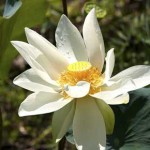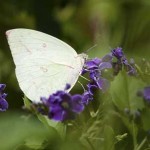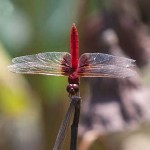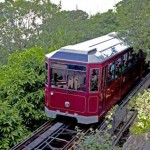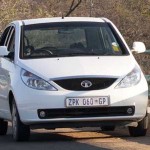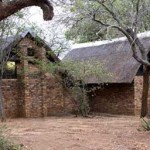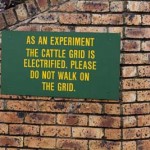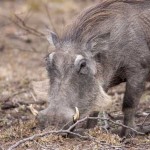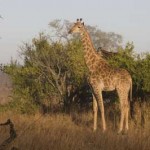The planning, plotting and research began in earnest. Missionary friends of Lydia’s in South Africa whole-heartedly recommended Kruger National Park. Lydia left the planning up to me (“since it’s your trip”). I opted to stay in the Park for the whole two weeks, having no desire to visit cultural exhibitions or do shopping or other “touristy” stuff; I just wanted to see and photograph the animals! To make the trip on our limited budget I asked her if she would be willing to “tent” it. Her reply was simple and to the point: “I can do anything you can do!” So one of her big pieces of luggage contained all the equipment we needed for camping. One of mine contained a lot of dried food, my sleeping bag, flashlights, etc. We hand-carried all the camera equipment, not daring to let it out of our sight.
As departure time neared, I had a small twinge of anxiety about getting it all together. It had been a long since I had flown and I knew there had been a lot of changes at airports. For instance, I checked-in on-line and wasn’t sure what to do with myself when I got to the airport. Once again, Lydia came to my rescue! Funny how things change over the years. When we did the book together I was doing all the orchestrating, planning, staging, writing and photographing with a little girl who was just following instructions. Now here I was very dependent on her travel expertise and “worldly know-how!”
I left home on August 10th and flew to San Francisco; Lydia drove in from Redding and somehow found me amidst the acres and acres of concrete and bustle! We ensconced ourselves next to an unmanned ticket counter and proceeded to repack all our luggage, taking advantage of the convenient baggage scales. We certainly didn’t want to pay extra for overweight luggage. To our surprise, the large pieces that were to be checked weren’t a problem, but the small hand carries were! With an allowance of only 15# it soon became clear that each of the telephoto lenses had to be in separate bags allowing only small stuff to be added.
We kept shuffling until every bag passed the weight test and finally we were on our way at 1:30 a.m. on August 11th. But not to Africa – to China! Definitely the long way around (Frequent Flyer beggars can’t be choosy!). The flight took 13 hours, then we had a layover of 12 hours there. Lydia had done the research as to what we might do during the 12 hours and insisted that sleeping in a corner somewhere in the airport was not one of the options.
So we exchanged a little money, bought bus tickets and bravely set off to see what we could see in Hong Kong. First stop was the Water Park where we enjoyed the beauty of the natural world nestled among unending skyscrapers (mostly apartment buildings). The Park was very well done.
Next on the schedule was to go to the Peak. We found our way to the trolley station and waited in line for more than an hour to get onboard. The trip is a great trolley ride straight up the mountain with spectacular views and a cool breeze on top. But by then I had a problem that just wouldn’t go away; my feet were so swollen from the 90-degree temperature, the high humidity and walking for hours on blistering pavement, that my heels had open blisters and my ankles ached from the top of the shoe rubbing against them causing bruises.
We had planned on the weather being hot in Africa, but hadn’t given a thought to the weather in China. My two pair of sandals were packed in the suitcase which was checked through to Johannesburg – along with a ziplock bag full of sorely-needed (no pun intended) bandages. When we finished exploring the Peak we rode back down and tried to find the way to our bus stop. After several limping, agony-filled turns around different blocks, I finally plopped down on a bench and said “that’s it, I can’t walk another step.”
Lydia said “OK, what shall we do?” Ever too cheap to pay for a taxi or to buy a pair of sandals that I didn’t need, I quickly replied “I will walk in my stocking feet!” I did, and have the blackened socks to prove it. I got some curious stares and I’m sure comments consisted of “those crazy Americans” but at that point I was perfectly comfortable and could have walked for miles and who cares about being politically correct or committing social faux pas! We finally found the bus stop we needed and made it back to the airport in plenty of time.
Then another long flight (12 hours again) put us in Johannesburg at 7:00 am. Scurrying around we got our luggage (safe, sound and intact) and met the friend that was going to take some goodies Lydia had brought to missionaries she knew. On to the phone store to rent a phone – (safety rule #1, don’t go into the Park without a phone and unfortunately, mine wouldn’t work there) and then to exchange money. At the car rental counter we were able to plug in the computer and send a quick email home telling the folks we had arrived safely. At last we were in the garage getting the car loaded. I had asked for the “cheapest” car they had – and we got it! It was about the size of a glorified lawn mower with limited space for luggage. I asked Lydia if she wanted me to drive and she replied “no, you’re on vacation – I’m driving – you just sit back and relax.”
In your dreams!
The next words out of her mouth were half accusatory and half dismay: “you didn’t tell me it was stick shift!” Oh, and did I mention that they drive on the wrong side of the road there? Well, you learn to swim by jumping in and that’s what we did. After easing our way to the exit, the quietness of the parking garage vanished abruptly as we found ourselves in heavy, four-lane traffic zipping by at 50 mph (only they call them kilometers there, of course). Lydia was attempting to shift with her left hand, jabbing at the turn signal (which was actually the windshield wipers), and trying her best to remember to drive on the wrong side of the road. I wanted to be helpful and read signs and compare them with the map and directions, but I wasn’t doing a very good job amidst the honking and fist-shaking, flapping windshield wipers (it wasn’t raining) and the grinding of gears. I seriously thought we might not make it to the Park – a five hour drive away! Who’s worried about wild animals – this seemed a lot more dangerous to me!
Within a few miles she was driving like the natives, which means pulling off on the shoulder at full speed to let cars pass even in the face of oncoming traffic in a two-lane highway. When in Rome….
We stopped at the “petrol plaza” Alzu which had been recommended by friends. It was alive with visitors getting gas, buying souvenirs, snacks and watching the wildlife held captive in the fields outside the building. We had lunch in the restaurant there and got back on the road. Arriving at the Spar grocery store in Malelane, we bought groceries and an ice box then drove the last few miles to Malelane Gate – one of the entrances to the Park on the South end. After getting paperwork done there and buying a guide, we drove another 10 miles or so to the first Rest Area – Berg En Dal.
Many people have expressed amazement that we slept in a tent. We’re really not that brave. The Rest Areas offer campsites, permanent safari tents and huts for sleeping arrangements. They also have communal bathrooms, with showers (called “Ablutions”), outdoor kitchens for cooking with two-burner hot plates and hot water for washing up after. Each of these camps is enclosed with a gate and an eight-foot electrified fence. As our son put it “the people are locked in the cage and the animals walk around the outside looking in.” He got it exactly right. Everyone is required to be in the gate before it closes at 6:00 pm and cannot leave until it is opened at 6:00 am the next morning. No one is allowed to be on their own in the Park at night. The exception is those who are staying in private lodges, which may or may not have fences around them and the folks are able to go out with guides under certain conditions. So we were perfectly safe and I slept very peacefully every night, except the second night when the thermometer dropped into the 40s accompanied by a nasty wind and rain.
The calendar said it was the last two weeks in August, but there were no “dog days of summer,” since it was the end of winter there. The locals were complaining that winter was lingering. It was in the 80s every day and usually in the 50s at night – as far as I’m concerned that was very pleasant and that’s why Lydia (who had done the research, knowing I don’t do well in hot weather) had recommended that time of the year. The down side was that there were only a few trees that were beginning to get leaves on them, and not many birds had arrived from the Northern Hemisphere to spend our winter months there in a warmer climate. The upside was the weather was very dry – not the rainy season – and therefore we didn’t have the complications that go along with it; i.e. mosquitoes (which carry malaria), muddy, flooded and/or impassable roads and dust that ruins your camera equipment to mention just a few. All said and done, I’m thinking we were there at the perfect time of year.
Our travel plans were to start in the south and work our way slowly to the north end of the Park which is the length of the country of Israel and covers 12,500 square miles. To that end, we had reservations in 7 different rest camps, staying two nights at each except one; moving ever northward. The practice was to be out the gate when it opened every morning and, following the guide book, drive all the little, winding, dirt side roads past the water holes and away from the main road. We could easily use up the 12-hour day in this manner, each evening getting back to the campsite with only minutes to spare.
Some days started off with a bang – having terrific animal sightings within a mile from the camp - and others just a constant trickle of wildlife throughout the day with some “dead” times thrown in to make us look at scenery or crawl into the back seat to dig out something to eat. Getting out of the car was forbidden. Being accustomed to people pushing the envelope, the warnings went so far as to say “no body parts outside the car!” There were several days when the car door wasn’t opened from the time we got in it in the morning until we arrived back at the campsite that night. On three occasions, we stumbled upon picnic areas that were very well-kept, had outhouses, tables, grills, etc. The signs at these spots would read “You may alight from your vehicle at your own risk!” We always did and weren’t bothered by more than the Yellow-billed Hornbill – their version of the all-too-common “Camp Robber.”
Of course the first sightings of any creature were the most exciting: “Look, giraffes!” But we quickly goto the point of “Ho-Hum, just another elephant herd!” Nevertheless we would stay and watch and hope for that million-dollar shot. We were never disappointed (except for the lioness that slept peacefully for three hours!) and usually felt exhilarated from having seen “something different.” The first day at a new camp site we would drive in the area, covering as much ground as we could before returning to the camp. The second morning we would get up early, take down the tent and get everything packed in the car and work our way to the next campsite. At the last two campsites we finally got smart and on the first day would take everything out of the car and leave it in the tent. That way I could sit in the back seat, moving from side to side as necessary and Lydia could have the passenger seat on which to lay her camera equipment – and also be able to take pictures out either side of the car. She often had to turn the car cross-wise in the road in order for one of us to get clear shots. It was impossible to take a picture through the front windshield because it was very slanted and all the images looked fuzzy. Animals in the 11:00 or 1:00 position, were also difficult because the car had rearview mirrors half as big as the vehicle! Those mirrors ended up in a lot of shots! Next time I’m going to take a screw driver or maybe a sledge hammer and my first task will be to get rid of the mirrors. If the subject was in the 7 or 8:00, or 4 or 5:00 position, it was equally hard. Imagine trying to hand hold a lens that weighs 10# while turned backwards in a tiny bucket seat! Most successful pictures were taken at a 90-degree angle to the car. I had made bags which we filled with dry beans when we got there; the bags were placed on the window sill and the camera sat on that – a nice, solid foundation. I was shooting with a Canon 40D, using a 28-70mm zoom lens, a 70-200mm zoom (which became a 140-400mm when combined with a 2x converter), or a fixed 300mm lens with the 2x making it 600mm. Lydia was using a Canon 20D with a 28-135mm zoom or a fixed 400mm telephoto. If the critter(s) were on her side and she needed more fire power, she took the pictures on my camera with the 600mm.
Next Blog: Animal Adventures!

